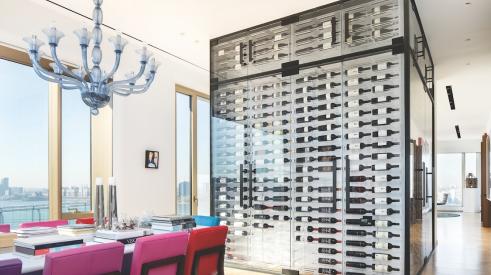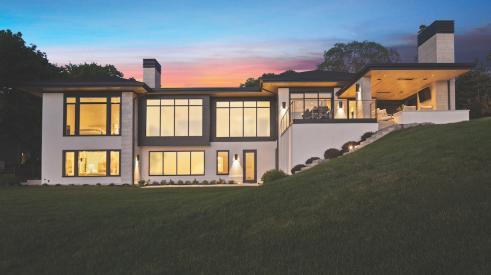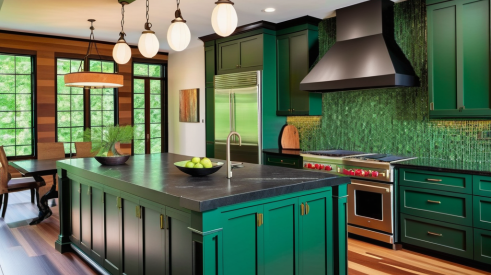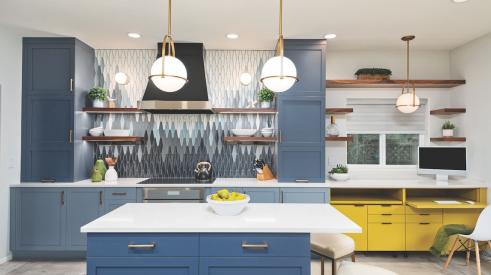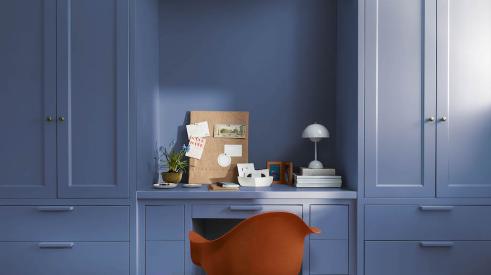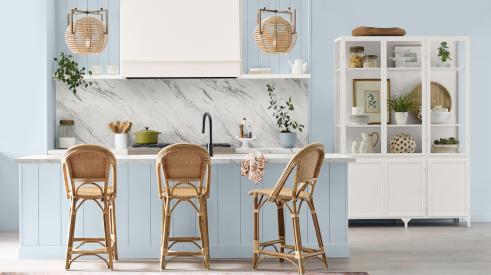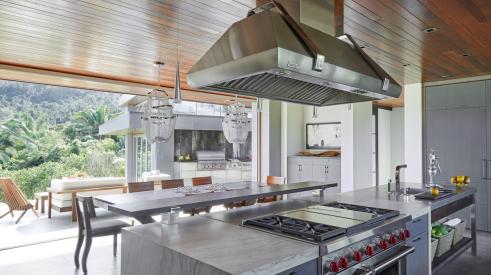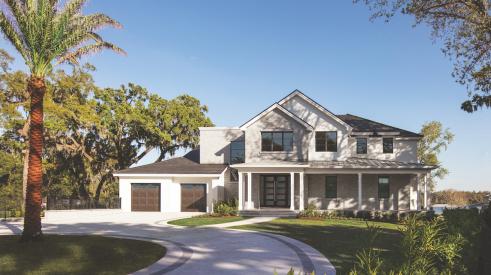| With technology changing rapidly, pre-wiring is the key in keeping a system from becoming obsolete, says Bob Pafundi. Different wires are designed for different functions, but all the wires in this project run back to a rack of computer equipment in a temperature-controlled closet. "We are cognizant about the need to hide equipment behind closed doors," Pafundi says. The equipment can generate a lot of heat, so special fans are designed to extend the life of the components. |
| Along with sophisticated components comes the need for simplicity. Most clients don't want to know about the system, Pafundi says, just that it works. They don't want to have to read a manual in order to operate it. They don't want to have to do anything. The only interface in this home's system is the touch pads in each room; there are no amplifiers to adjust, no thermostats to regulate. The system can even be serviced over the Internet, avoiding the need for most service calls. |
The classic television room has been transformed into a high-tech computerized space that looks nothing like the traditional family gathering place. The idea is not to have a room dedicated for watching TV but one that's adaptable for many activities.
Although located in an office building built in the 1920s, this renovated loft condominium in downtown Atlanta features state-of-the-art technology and reflects the homeowner's passion for the arts. For the media room, the homeowner wanted a system that controlled everything, but he didn't want the components to be visible, says designer Bob Pafundi of Sensory Solutions in Atlanta. "We made sure they were camouflaged." To achieve this, Pafundi worked with the architects, Zaic-Hug & Associates; the builder, Wes Willard; and Sensory Solutions lighting designer Taylor St. Clair.
The homeowner wanted speakers that produce great sound but are heard and not seen. Speakers in walls and ceilings were designed and placed for maximum audio effect and to be painted over to eliminate visual distraction. The centralized computer-like system controls sound throughout the home. The ability to listen to satellite radio stations and to download all the homeowner's compact discs into the hard drive provides "all of his music at his fingertips without having to touch a disc," Pafundi says.
Décor was significant in how the media room was designed. The computer-controlled lighting system's pre-programmed lighting scenes enhance artwork and significant architectural features.
The more complex the system, the less attention should be drawn to it, Pafundi says. In this home, "when you walk in the media room, there is no evidence that there is a TV." Wall panels hide a 42-inch, flat-screen plasma TV. When open, the panels not only reveal the TV but also become the speakers on each side of the screen.
The homeowner didn't specify the equipment he needed but wanted a sophisticated system that had all the bells and whistles while still being simple to use. "He wanted the end result," Pafundi says. "He wanted to be able to push a button and not worry about the components. That's what he came to us for." The entire hidden system cost "six figures," including audio, video, design work, installation, programming, lighting control and fixtures, and the phone system. The system is controlled by discreet touch pads in each room and by remote control.
Media Room
Add new comment
Related Stories
Designing, Building, and Installing a Luxury Custom Wine Cube
An 11-foot wine cube enveloping a pantry is the stand out feature of this customized New York penthouse
Marvin Releases Switchable Privacy Glass Window
The privacy glass windows can be purchased from Marvin's Direct Glaze windows
Building A Small Projects Division from the Ground Up
Through hard work and careful strategy, Harth Home Services has seen big growth
Client Design Choices in the Time of Social Media and AI
Social media speeds up the trend cycles, and now artificially created images are falling into homeowners' hands
Design Trends to Watch in 2024
What’s in and out for the upcoming year? Remodeling designers share insights
Insights for Designing Outdoor Kitchens
Was the pandemic-fueled thirst for outdoor kitchen remodels and additions a fluke, or is it here to stay? Plus: The top design considerations for outdoor kitchens
Home Run Remodeling Lessons: The New American Remodel 2023
A final look at The New American Remodel 2023
Webinar: From Disjointed Design to Cohesive and Efficient—The New American Remodel 2023
Access the recording for the first The New American Remodel webinar held on March 8 at 2 pm CT



